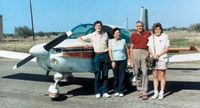- COVID-19
- Biosimilars
- Cataract Therapeutics
- DME
- Gene Therapy
- Workplace
- Ptosis
- Optic Relief
- Imaging
- Geographic Atrophy
- AMD
- Presbyopia
- Ocular Surface Disease
- Practice Management
- Pediatrics
- Surgery
- Therapeutics
- Optometry
- Retina
- Cataract
- Pharmacy
- IOL
- Dry Eye
- Understanding Antibiotic Resistance
- Refractive
- Cornea
- Glaucoma
- OCT
- Ocular Allergy
- Clinical Diagnosis
- Technology
Spin, roll, soar
Joseph L. Demer, MD, PhD, acknowledges that stunt flying makes even the pilot flying the plane sick. But for part of his 22 years of flying, Dr. Demer did stunts in the skies over California.
Joseph L. Demer, MD, PhD, acknowledges that stunt flying makes even the pilot flying the plane sick. But for part of his 22 years of flying, Dr. Demer did stunts in the skies over California.
"It's worth it when you love it," he explained.


Taking off
Dr. Demer began this hobby as a first-year resident at the Baylor College of Medicine in Houston.

Dr. Demer said that he always wanted to fly. His father was a pilot and a flight instructor after World War II.
"It was always a dream in school. My uncorrected vision wasn't good enough to join the Air Force to become an astronaut or military pilot," he said. "As a medical student/intern, I felt confined by the loads of responsibility. The idea of flight was liberating and possible at that point."
He earned his instrument rating, multi-engine rating, and is close to a commercial rating. His interest in improving his flying skills led him to aerobatic flying.
"Stunt flying is a good way to train. Doing aerobatic flying helps prepare pilots for emergency situations," Dr. Demer said. He learned loops, rolls, spins, stalls, and more from an instructor and would spend alternate weekends in a rented stunt plane working on his stick and rudder skills.
"There are strict legal requirements for stunt flying. It's only possible in specific areas and pilots must wear parachutes. It's dangerous if done incorrectly, because the plane can come apart! The pilot has to watch the G-meter and be ready to bail out if necessary. It's not all intuitively obvious," said Dr. Demer.
His practiced aerobatic skills have saved his life at least once. He remembered, "Once, I was piloting a regular plane when a valve broke in the engine. The plane was going down. I used stunt skills to glide through a hole in the clouds and was able to land the plane on a bare patch in a wilderness area."
Gentler flying
Dr. Demer has begrudgingly given up stunts in the years since Sept. 11.
